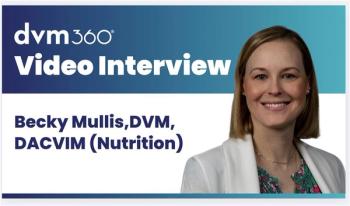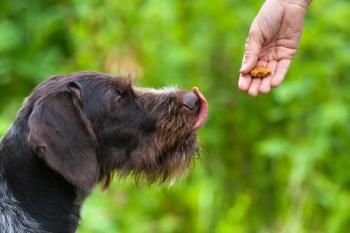
Can diet help in managing pancreatic diseases? (Proceedings)
Pancreatic exocrine insufficiency (PEI) - malassimilation of nutrients
Pancreatic exocrine insufficiency (PEI) - malassimilation of nutrients
Clinical presentation
- Low body weight and condition
- Stunt growth
- Veracious appetite
- Diarrhea (usually characterized as osmotic) large soft, greasy, voluminous, foul smelling pale yellow/gray, cow-plop paddy, defecate frequently (six to 10 bowel movements per day)
- Vomiting and anorexia – rare may indicate an additional problem (IBD)
Signalment and etiology - 80-90% (people) loss of functional before get clinical signs
- Often seen in young (6-18 months) large breed (German shep and Collies)
- Juvenile EPI in dogs results from atrophy of pancreatic acinar tissue
- Congenital pancreatic hypoplasia has not yet been described in dogs or cats
- Older dogs related to chronic pancreatitis
- Chronic pancreatitis is the more common cause of EPI in cats and humans.
- Less common reasons are pancreatic or extra-pancreatic masses that create pancreatic duct obstruction
- Do healthy dogs need enzyme supplements - no
Digestive enzymes from pancreatic acinar origin play an integral role in the assimilation of all nutrient groups. A lack of pancreatic digestive enzymes leads to malassimilation in two ways:
- Maldigestion: inefficient or deficient breaking down of macromolecules: Protein, fats and carbohydrates
- Malabsorption: disabled intestinal mucosal transport mechanisms for the end products of digestion: mono, di-saccharides, amino acids, and fatty acids which may be due to a lack of ‘trophic' factors that are secreted by the normal pancreas
Clinical signs result from
- Undigested and fragments of food pass through the SI causing voluminous, watery, notably steatorrheic feces.
- Lack of protein and calorie (fat and carbs) absorption results in poor weight gain or loss
- Other nutrient deficiencies noted
- Vitamin B12 concentrations are undetectable/markedly decreased in nearly all cats and >80% of dogs with EPI.
- Serum folate concentrations
- dogs are often increased ~ presence of secondary SI dysbiosis
- cats are often decreased ~ concurrent small intestinal disease (IBD)
- Vitamin K responsive coagulopathy is rare but has been reported
Relationship to diabetes?
People with chronic pancreatitis ultimately loose both exocrine and endocrine functions but the diabetes usually appears later. It is unclear whether chronic pancreatitis does lead to diabetes in the dog or cat.
Diagnosis
- Routine blood tests are within the normal range in most cases
- Unremarkable abdominal radiography and ultrasonography
- Serum trypsin-like immunoreactivity (TLI) in dogs and cats have been developed and validated - highly specific for EPI in both dogs and cats.
- dogs with a serum cTLI of £ 2.5 mg/L have EPI
- cats with fTLI £ 8.0 mg/L have EPI
- Serum pancreatic lipase immunoreactivity (PLI) has been developed and validated for use in dogs and cats. PLI is highly specific for EPI but there is some overlap of serum cPLI concentrations between healthy dogs and dogs with EPI. (Steiner 2011)
Treatment
- Very successfully treated using dietary pancreatic enzymes supplementation.
- Dried extracts of bovine or porcine pancreas are available (e.g., ViokaseÒ or PancrezymeÒ). Overall clinical impression is that powder is more effective than tablets, capsules, and especially enteric-coated products which has been substantiated in people with EPI
- Raw chopped pancreas (porcine, bovine, venison) 30-90 g = one teaspoon of pancreatic extract can be kept frozen for several months. Slight risk of transmission when handling raw pancreas
- Aujeszky's disease from raw pork pancreas
- BSE from raw bovine pancreas
- Echinococcus from raw game pancreas
- Often recommended but not needed:
- Pre-incubate food with pancreatic enzymes before feeding
- Supplementation with bile salts
- Antacid therapy
- Can gradually decreased to the lowest effective dose which can vary widely among patients depending:
- the degree of pancreatic loss
- the activity (batch to batch) of the pancreatic supplement
- diet fed (digestibility, fat and fiber content)
Fat absorption may not normalized by enzyme supplementation (in people and dogs with EPI) even with weight gain and normal stools due to gastric pH and lipase activity
- Low gastric pH – depresses supplement lipase, but
- Rise gastric pH – depresses gastric lipase – no net gain
Choose base diet carefully
- High-fat food (>27% DM fat) + pancreatic enzymes was been associated with increased defecation frequency, poor fecal consistency and higher fecal fat in EPI dogs compared to when fed lower fat diets (15% DM fat) + enzymes was fed.
- EPI dogs fed a low-fat (7% DM), high-fiber (25% DM) + pancreatic enzymes had mild weight loss, ate more food and had increased fecal mass and defecation frequency likely attributable to the low fat/caloric content and the effect of high fiber levels on dry matter digestibility. Stool quality was considered good (firmer) as compared to feces produced when the dogs were fed higher fat foods.
- Can use OTC ‘growth' diet but may need more enzyme ($$). The combination of a highly digestible commercial veterinary therapeutic food + pancreatic enzymes provided more metabolizable energy to dogs with EPI than a grocery brand food + the same pancreatic enzyme.
- Use a “highly digestible” diet – What exactly does that mean?
- Diet Digestibility is based on individual nutrient digestibility coefficients
- Highly Digestibility = Fat digestibility > 90%; Carbohydrate digestibility > 90%; Protein digestibility > 87%
- Protein ingredients such as egg, cottage cheese, muscle and organ meats (aka … meat by-products) are highly digestible
- Carbohydrate ingredients such as corn, rice, barley and wheat are highly digestible when properly cooked by both the dog and cat
- Overall fat digestion from a ‘highly digestible' food + pancreatic enzymes can exceed 70% in dogs with EPI
- Decreasing the fiber content from 4% to less than 1% in a study of people with EPI decreased fecal weight and fat excretion by one-third and reduced bloating and flatus
- Hence patients may require 15-25% more food to maintain optimal body weight as listed on the recommended feeding guides
Other nutrient deficiencies
- Fat soluble Vitamins: Vital E-A+D 0.5-1 ml deep IM injection divided into 2 sites
- Vitamin B12 need be administered parenterally:
- 250 µg in cats
- 250 -1,500 µg in dogs
- weekly SC for 6 weeks then one more dose a month later,
- re-evaluate.
- Serum folate concentrations:
- dogs with SI dysbiosis may need antibiotics (tylosin at 25 mg/kg q 12 hrs for 6 weeks).
- cats with IBD may need other medications concurrently
Pancreatitis
Several breeds are predisposed to pancreatitis: miniature schnauzers, briards, Shetland sheepdogs & Siamese cats - predisposition may be attributed to hypertriglyceridemia
- Mutations in the pancreatic secretory trypsin-inhibitor gene (SPINK gene) have been described in miniature schnauzers which may explain this breed's increased risk for pancreatitis.
- 59% of dogs and 46% of cats with exocrine pancreatic lesions had evidence of pancreatitis.
Risk factors
- Comorbidities: Diabetes mellitus, Hypothyroidism and Hyperadrenocorticism
- Hyperlipidemia: Free fatty acids are toxic to the pancreas
- Hyper triglyceridemia (> 1000 mg/dl fasted sample)
- Obesity (abdominal: para endocrine subclinical inflammatory state
- High fat diet/meal (>20% dry matter):increase stimulation of CCK
- Hypercalcemia: induces pancreatic injury via a secretory block, accumulation of secretory proteins, and possibly activation of proteases.
- Ischemia-reperfusion: Trauma
- Drugs: Azathioprine, Corticosteroids, L-asparaginase, Organophosphate insecticides (cats)
Clinical presentation – dependent upon severity
- Dogs: Mild cases may remain subclinical. More severe cases may present with anorexia, vomiting, weakness, abdominal pain, dehydration and diarrhea. Severe cases can present fever or cardiovascular shock.
- Cats: less specific clinical signs. Lethargy, anorexia, dehydration, hypothermia, vomiting, abdominal pain, a palpable abdominal mass, dyspnea, ataxia and diarrhea.
- Cytokines are playing an more important role in the progression of pancreatitis, then the subsequent development of systemic complications. Develop a serum assay for key cytokines
Diagnosis
Pancreatic lipase immunoreactivity in dogs and cats (cPLI and fPLI, respectively) have been developed and validated. Immunoassays does allow for the specific measurement of lipase originated from the exocrine pancreas.
Etiopathogenesis – diet related
- Foods high in fat and/or protein (arginine) stimulate production / release cholecystokinin, gastrin, secretin.
- Cholecystokinin – principal physiologic mediator of pancreatic enzyme secretion
- Hyperstimulation of pancreas (any cause) -> increased production of intracellular pancreatic enzymes -> intracellular (acinar) enzymatic activation -> auto digestion of the pancreas -> inflammation and mediator release -> cycle continues.
- Then self- perpetuating - Auto digestion of pancreatic tissue with associated inflammation is self-perpetuating and can eventually affect exocrine & endocrine functions.
Dietary management of pancreatitis
- Acute or short-term case:
- NPO for 1-3 days to minimize dietary stimulation to the pancreas allowing the inflammatory reaction to subside.
- Slowly re-introduce liquids (water, ice cubes, rehydration solutions, monomeric foods) @ 1-2 ml/kg BW for 1-2 days.
- Monomeric foods are elemental forms of nutrients (amino acid, simple sugars and triglycerides using MCTs. Best examples: Nestle Peptamen, Abbott Periative
- Slowly introduce & increase amount solid foods (low fat, moderate protein) over 3-7 d
- Solid food diet based on clinical picture and etiology of pancreatic overstimulation:
- If fat-induced, see very high fasting TG's; choose low <8% fat DMB diet for re-feeding
- If trauma or drug induced, see normal fasting TG's; choose moderate 10%-15% fat DMB for re-feeding
- Transition (1-2 weeks) to appropriate non-therapeutic diet with appropriate fat level.
- Chronic or long-term case (NPO > 3 days):
- Not vomiting - consider Continuous Rate Infusion (CRI) of low fat monomeric diet is least stimulatory to pancreas: CRI @ 1-2 ml/kg BW for 1-2 days via naso-esophageal tube
- Slowly re-introduce liquids (water, ice cubes)
- Slowly introduce & increase amount solid foods (low fat, moderate protein) over 3-7 d
- Prolonged vomiting consider parenteral feeding until vomiting resolved; Use IV protein, fat and dextrose - not stimulatory to the exocrine pancreas.
- Consider Coram specialty infusion services for IV solutions
- Slowly re-introduce liquids (water, ice cubes) orally
- Slowly introduce & increase amount solid foods (low fat, moderate protein) over 3-7 d
- Feed according to feeding guidelines but in 4-6 meals/day
Therapeutic low fat (+/- fiber) canine diets
- see NAVC Clinician's Brief Sept 2014 vol 12(9):87
- see http://www.cliniciansbrief.com
Therapeutic low fat (+/- fiber) feline diets
- see NAVC Clinician's Brief Sept 2014 vol 12(9):87
- see http://www.cliniciansbrief.com
Ultra-low (2-4%) fat diet options for chronic cases (2+ ICU hospitalizations for pancreatitis)
Homemade diet requires specific formulation by a nutritionist for a complete and balanced recipe to be fed long term with 25% protein, 2-4% fat and 7% fiber on a dry matter basis. See http://www .acvn.org to locate nutritionists.
Newsletter
From exam room tips to practice management insights, get trusted veterinary news delivered straight to your inbox—subscribe to dvm360.






